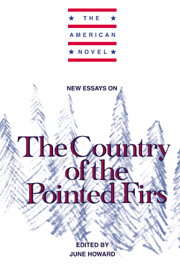Book contents
- Frontmatter
- Contents
- Series Editor's Preface
- 1 Introduction: Sarah Orne Jewett and the Traffic in Words
- 2 Country's Portrayal of Community and the Exclusion of Difference
- 3 Gender and American Realism in The Country of the Pointed Firs
- 4 Material Culture, Empire, and Jewett's Country of the Pointed Firs
- 5 Regionalism and Nationalism in Jewett's Country of the Pointed Firs
- Notes on Contributors
- Selected Bibliography
3 - Gender and American Realism in The Country of the Pointed Firs
Published online by Cambridge University Press: 08 January 2010
- Frontmatter
- Contents
- Series Editor's Preface
- 1 Introduction: Sarah Orne Jewett and the Traffic in Words
- 2 Country's Portrayal of Community and the Exclusion of Difference
- 3 Gender and American Realism in The Country of the Pointed Firs
- 4 Material Culture, Empire, and Jewett's Country of the Pointed Firs
- 5 Regionalism and Nationalism in Jewett's Country of the Pointed Firs
- Notes on Contributors
- Selected Bibliography
Summary
EVER since the publication of The Country of the Pointed Firs in 1896, Sarah Orne Jewett has been accorded a fairly consistent place in the American literary canon, although even her most enthusiastic partisans have felt compelled to insist that this place is very small. Thus Henry James, in a 1915 essay, describes the “minor compass” of Jewett's art and praises (if that is the right word) “her beautiful little quantum of achievement”; Willa Cather writes in a 1936 memoir that Jewett “was content to be slight, if she could be true”; Warner Berthoff, in a 1959 essay on The Country of the Pointed Firs, concludes that the book, “with a secure and unrivaled place in the main line of American literary expression,” is “a small work but an unimprovable one.” Yet the consistency and endurance of Jewett's literary reputation, however hedged by diminutives, make her almost unique among American women fiction writers of the nineteenth century. And the place of The Country of the Pointed Firs in what Berthoff calls “the main line of American literary expression” has not simply depended on critical taste, at least not overtly; it has also been secured by the work's supposed location within the categories of official American literary history, the literary history that structures anthologies and academic curricula. Ever since William Dean Howells declared his so-called Realism War in the 1880s, only a decade before Jewett's book was published, a rugged commonplace of our literary history has been the notion that the great development in American fiction after the Civil War was the rise of realism.
- Type
- Chapter
- Information
- New Essays on The Country of the Pointed Firs , pp. 61 - 80Publisher: Cambridge University PressPrint publication year: 1994
- 1
- Cited by



